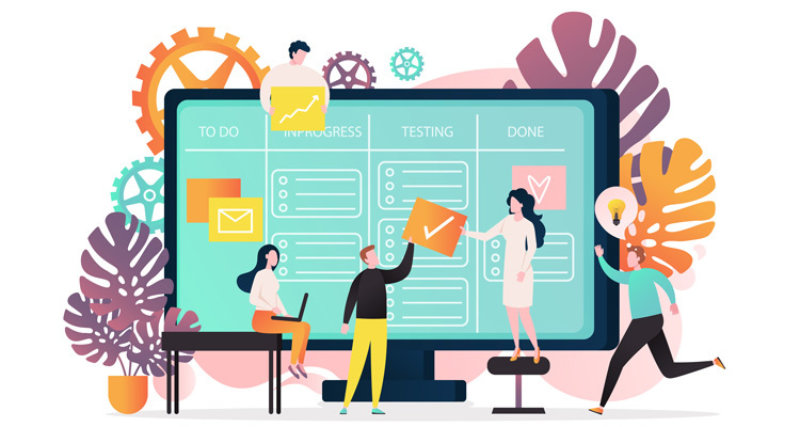
There are many reasons why your team might currently be using a physical Kanban board rather than an online Kanban board. For one, using a physical Kanban board is a great way to learn the fundamentals of Kanban. It can get your team to commit to the idea of sharing work on a shared board, and comfortable with habits like ‘walking the board’ in a daily standup. For a co-located team that keeps a regular schedule in a shared office, a physical board can be a useful tool for keeping everyone aligned.
But the limitations of physical Kanban boards are many—including the fact that the accuracy of your board depends on all team members having physical access to it. This limits the possibility of modern working arrangements like working from home, working flexible schedules (not limited to 9-to-5 hours), and working remotely, all of which are viewed as morale-boosting perks in many work cultures. To update your board design or even just the status of a ‘card’, you have to make these changes to your physical board—and then make sure that change is communicated to everyone it affects.
Beyond these logistical challenges, there are also smaller, more practical downsides to using a physical board: Poor penmanship can inhibit comprehension. If you’re using sticky notes as your Kanban cards, you’re increasing your carbon footprint—and allowing the accuracy of your board to be at the mercy of a strong gust of wind.
Finally, digital Kanban boards offer countless benefits that physical boards cannot, like the ability to keep comments, attachments, relevant links, and card history all in one place. With digital Kanban boards, you can connect related work items, and take their progress as a whole, communicated status upwards and outwards. All these benefits and more make it worth it to switch from a physical to an online Kanban board. Here’s how.
ALIGN AROUND YOUR ‘WHY’.
Before making the switch to a digital Kanban board with your team, make sure to have a conversation as a group around why this switch is being made. It’s likely that most of your team will already be “on board” (pun intended!) but like with all group decisions, alignment is key.
Discuss the benefits of a digital Kanban board, what you hope to achieve by switching to a digital board, and what features you’d like to begin using as part of this new implementation.
CHOOSE THE RIGHT DIGITAL KANBAN TOOL AND PROVIDE TRAINING.
There are several online Kanban tools on the market, each offering a different mix of features. We’re partial to Planview AgilePlace, which combines the flexibility and ease of use of a team tool with the scalability and reporting of an enterprise tool. Based on your team conversation about which features are most important to you as a team, narrow down a list of tools to test out and choose one that makes sense for your team.
Before you start moving your work over to the new tool, discuss a transition plan as a team. When do you plan on being officially ‘on board’ with your new digital board? Who will be responsible for moving tasks onto the board? How will the team undergo training on the new tool so they can hit the ground running?
Establishing these details up front will help make the transition to a digital board smoother and more likely to ‘stick’.
CREATE A DIGITAL COPY OF YOUR PHYSICAL BOARD.
It can be tempting to start experimenting with new board layouts as soon as you make the switch to a digital board. Resist this urge until everyone on your team has had a chance to familiarize themselves with how the digital Kanban tool works, so they’re not having to learn how to use the tool and use the new board layout at the same time. (Here’s how you edit your board layout in Planview AgilePlace.)
DECIDE HOW TO USE NEW (TO YOU) FEATURES.
As we mentioned above, online Kanban boards offer many new features that physical boards do not, which can affect how the team interacts with and uses the board. For example, if your team didn’t use due dates on the physical board, and then some team members began assigning due dates to tasks on the digital board, this could cause some confusion or even tension between team members.
If you hold a daily or regular standup meeting with your team, add a question that encourages the team to reflect on how the board is being used, as well as any observations about how new features can be incorporated to your team’s workflow in a productive way.
CONSIDER ADDING LANE POLICIES AND WIP LIMITS.
One of the most potentially impactful features of a digital Kanban board is the ability to add lane policies and implement WIP limits.
Lane policies allow you to build a set of guidelines for board usage into your board. (Here’s how you add lane policies and other lane details in Planview AgilePlace.) This can be especially helpful as your team adjusts to its new digital Kanban board.
WIP limits are guidelines that help you better manage how much work you or your team have in process. By limiting your work in process by implementing WIP limits, you can boost productivity, reduce context switching and other forms of stress related to having too much WIP, and enjoy the full benefits of Kanban. (Here’s how you set WIP limits for lanes in Planview AgilePlace.)
HOLD A RETROSPECTIVE.
After a few weeks of using your new digital Kanban board, hold a meeting to discuss how the transition process has been for everyone involved. This is also a great opportunity to discuss potential improvements to the board, and how to begin to incorporate board metrics into your team’s workflow.
Holding a meeting like this periodically can help to make sure that your team practices continuous improvement not only in what it works on, but in how it gets work done.




